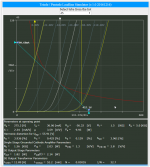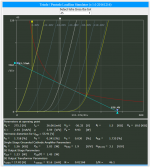Anyone know why such a high 12k primary for the 45 transformer?
Edit: this is in reference to the NP Acoustic transformers.
Me thinks this might be for 801a.
i think the 10k is just better.
5k is "shooting into knee" , i hate that sonically
same loudness, but not the THD profile !
I like 7k for the 45, but primary inductance, frequency response, power, etc. all play such important role.
Last edited:
I like 7k for the 45, but primary inductance, frequency response, power, etc. all play such important role.
7kohm load impedance at what frequency?.
Load impedance is a function of primary inductance with respect to frequency. And that inductance figure for air gapped types depends on DC current through the core.
Change the frequency for a given amount of inductance, and the load impedance changes.
For example, I would like load impedance to be 2x Rp at my lowest usable frequency. That makes sense, a lot of sense.
I know of one winder (recent inquiry, US based, self proclaimed winder of 20,000 items sold), who does not understand this as fundamental, he does not specify, but when asked he admits that his 'impedances' are measured at 1kHz. Then again, maybe he does understand and is chasing better HF response due to less capacities (there is more than one internal capacitance involved) within the transformer. Or perhaps its just a matter of convenience and he doesnt really care - take your pick.
If I see primary inductance specification at a given DC current through the core, I am happy - I can work out the loading to my tube at ANY frequency. Simple.
If I see a '3k3' with in circuit measurement utilising 800 Rp tube at 80mA and quotes -3dB(f) as such, I am happy - and I think it is the latter who fully understands that he needs to provide a bridge to those who do not really understand the nature of the relationship between inductance as it varies with DC current through the core, frequency and how this relates to the impedance which then loads the tube.
Again, to specify a transformer primary as simply an impedance by itself is meaningless.
Last edited:
Great info, I am definitely in the latter "don't know" camp 🙂 Any suggestions for recommended reading? Preferably an online source that explains this well.
I am using 6.4k OPT for my 45 SET wound by Electra-Print, this is for a headphone amp where very little power is needed. I am very interested in trying amorphous where low level information is critical for headphone use.
I am using 6.4k OPT for my 45 SET wound by Electra-Print, this is for a headphone amp where very little power is needed. I am very interested in trying amorphous where low level information is critical for headphone use.
Last edited:
7kohm load impedance at what frequency?.
Load impedance is a function of primary inductance with respect to frequency. And that inductance figure for air gapped types depends on DC current through the core.
Change the frequency for a given amount of inductance, and the load impedance changes.
Are you sure ?
Assume we have a typical output transformer with primary/secondary turns ratio = 22.36, which gives the impedance transforming ratio = 500. We connect 8 ohms load at the secondary and measure the reflected impedance from the primary at the frequencies 1 kHz and 2 kHz.
Do we get two different impedance values ?
Are you sure ?
Assume we have a typical output transformer with primary/secondary turns ratio = 22.36, which gives the impedance transforming ratio = 500.
We connect 8 ohms load at the secondary and measure the reflected impedance from the primary at the frequencies 1 kHz and 2 kHz.
Do we get two different impedance values ?
You are missing a point, which Hanze explained in post #185.
Of course the reflected impedances in your example are the same.
However, for a given impedance to be a real one the value of inductance can not be ignored.
In your example of 1 kHz, and the impedance ratio of 500:1 giving a load impedance of 4k at 8 ohm, the value of the inductance should be at least 637 mH (2.Pi.1000.0,637=4k).
This value of inductance at these frequencies is not a problem also for low quality output transformers.
It matters however at low frequencies; in your example the inductance at 20 Hz, with DC current through the primary, should be 31,83 H.
Now we enter territory where we see differences in quality in output transformers.
Another point to realize is the fact that inductance goes up with higher signal levels; a normal inductance meter only gives an estimation of reality.
Last edited by a moderator:
Coming back to NP Acoustics, I suggested that DIY Audio members might possibly have a discount. The reply, as much as I understand it, is that the first 10 buyers would get a discount. So it could be worth making contact and exploring this.
NP Acoustic OPT review
Here is the long overdue review of this OPT. I took measurements a year ago before installing them on my 4P1L PSE. Andy has the same OPTS and we are both delighted with them.
However, I'm still skeptical with the specs and in particular the performance of the 5K OPT. Either way, value for money is great
NP Acoustic Transformers – Bartola(R) Valves
I hope this review will help you on the decision to use them or not 🙂
Ale,
I hope, this OPT price will not jump into sky after your measurements 😀
Here is the long overdue review of this OPT. I took measurements a year ago before installing them on my 4P1L PSE. Andy has the same OPTS and we are both delighted with them.
However, I'm still skeptical with the specs and in particular the performance of the 5K OPT. Either way, value for money is great
NP Acoustic Transformers – Bartola(R) Valves
I hope this review will help you on the decision to use them or not 🙂
Ale,
Reading your review, you seem to expect more HF bandwidth from amorphous core transformers.
However, HF bandwidth is much more a result of winding technique and the influence of capacitance, much less of core material.
Reading your review, you seem to expect more HF bandwidth from amorphous core transformers.
However, HF bandwidth is much more a result of winding technique and the influence of capacitance, much less of core material.
Thank you very much Ale.
Very good posts from Hanze and Pieter.
I always prefer sound with 3k5 OPT than with 5K in my 300B SET.
Tried it with several upper-middle class of opt`s.
I use James 6123HS now.
Very good posts from Hanze and Pieter.
I always prefer sound with 3k5 OPT than with 5K in my 300B SET.
Tried it with several upper-middle class of opt`s.
I use James 6123HS now.
Last edited:
Hi PieterAle,
Reading your review, you seem to expect more HF bandwidth from amorphous core transformers.
However, HF bandwidth is much more a result of winding technique and the influence of capacitance, much less of core material.
I did not really, just highlighted the difference when compared to other OPTs. I’m aware that the winding technique is the major contributor on the HF response.
Glad to see you chipping in here, you’re the transformer expert!
PS: I hope to get the chance to test your great transformers at some point 🙂
Cheers
Ale
Great info, I am definitely in the latter "don't know" camp 🙂 Any suggestions for recommended reading? Preferably an online source that explains this well.
I am using 6.4k OPT for my 45 SET wound by Electra-Print, this is for a headphone amp where very little power is needed. I am very interested in trying amorphous where low level information is critical for headphone use.
I know of one winder (recent inquiry, US based, self proclaimed winder of 20,000 items sold), who does not understand this as fundamental, he does not specify, but when asked he admits that his 'impedances' are measured at 1kHz.
I can almost guarantee you that this 6.4k impedance was measured at 1kHz.. guess the cats out of the bag on that one now, oops.
I'm sorry that I cannot explain it in simpler terms, as for online resources, I really dont know.. I was fortunate enough to have someone explain this to me and over quite some time it gradually sank into my understanding.
Last edited:
I am very interested in trying amorphous where low level information is critical for headphone use.
Pieter at Tribute, or Monolith Magnetics in Belgium. I can vouch for the service offered by Ward and Yves at Monolith, and they offer in circuit specs, at full power (in the case of OPT), short lead time and impeccable fit and finish. My experience is limited to the S9, but I suspect would carry across to their other products. Also, they are approachable for custom stuff and the designer holds something along the lines of a doctorate in physics, which may or may not be of relevance, but if you check out the in-circuit BW, they are clearly understanding what they are doing, and I am not sure (given the previous fact) that profit margin is their main criteria.
Last edited:
You are missing a point, which Hanze explained in post #185.
What point ?
Change the frequency for a given amount of inductance, and the load impedance changes.
That statement needs some focusing.
Then find focus with your perspective, this was not intended as a tutorial - it seems that you are not quite understanding this, or the interactions in play as previously outlined.
Again, load impedance is a function of inductance wrt frequency, and inductance will vary with DC current through the core, and also to some extent the AC signal across the primary winding.
Again, load impedance is a function of inductance wrt frequency, and inductance will vary with DC current through the core, and also to some extent the AC signal across the primary winding.
Last edited:
Change the frequency for a given amount of inductance, and the load impedance changes.
Can you justify what you mean with this ?
- Status
- Not open for further replies.
- Home
- Amplifiers
- Tubes / Valves
- Best SE output transformer for 300B - shootout

